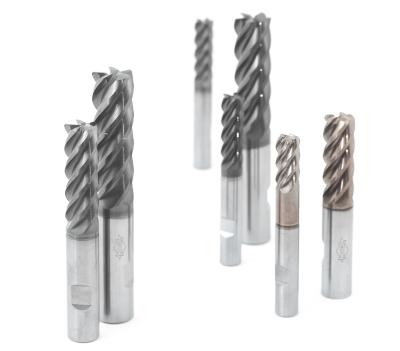
With trochoidal milling, significant improvements in terms of tool costs, clamping, processing times and load on the machine components can be achieved in many applications compared to conventional milling. For this milling technique, MAPAL has expanded its OptiMill product range by adding mills for the machining of titanium and high-alloy steels, as well as for hard machining.
As a result, new fields of application have been developed, such as structural components. A specially engineered, extremely unequal positioning of the five cutting edges in combination with an innovative geometric layout of the cutting wedge reduces vibrations. Counterbalancing conducted during the manufacturing process (balancing grade 2.5) lowers the risk of vibrations even further. As a result, the milling cutters of the OptiMill family can be used without problems even at high speeds.
To avoid the jamming, which results from the long chips produced through the sizable DOC, a chipbreaker is integrated, which divides the chips in half. This ensures the problem-free removal of the chips from the working space of the machine. All OptiMill milling cutters for trochoidal milling have a cutting edge length of 3 times diameter.
Contact Details
Related Glossary Terms
- chipbreaker
chipbreaker
Groove or other tool geometry that breaks chips into small fragments as they come off the workpiece. Designed to prevent chips from becoming so long that they are difficult to control, catch in turning parts and cause safety problems.
- conventional milling ( up milling)
conventional milling ( up milling)
Cutter rotation is opposite that of the feed at the point of contact. Chips are cut at minimal thickness at the initial engagement of the cutter’s teeth with the workpiece and increase to a maximum thickness at the end of engagement. See climb milling.
- counterbalancing
counterbalancing
Use of weights or mechanisms to balance a workpiece, grinding wheel, rotating tool or other device. Minimizes machining vibration and maximizes cutting force.
- gang cutting ( milling)
gang cutting ( milling)
Machining with several cutters mounted on a single arbor, generally for simultaneous cutting.
- milling
milling
Machining operation in which metal or other material is removed by applying power to a rotating cutter. In vertical milling, the cutting tool is mounted vertically on the spindle. In horizontal milling, the cutting tool is mounted horizontally, either directly on the spindle or on an arbor. Horizontal milling is further broken down into conventional milling, where the cutter rotates opposite the direction of feed, or “up” into the workpiece; and climb milling, where the cutter rotates in the direction of feed, or “down” into the workpiece. Milling operations include plane or surface milling, endmilling, facemilling, angle milling, form milling and profiling.
